
FARMACOLOGÍA PARA ESTUDIANTES DE ENFERMERIA
- Subject:
- Health, Medicine and Nursing
- Material Type:
- Lesson
- Author:
- Tania Romacho
- Date Added:
- 09/13/2024

FARMACOLOGÍA PARA ESTUDIANTES DE ENFERMERIA
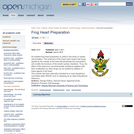
An isolated frog heart preparation is useful in the study of cardiac cell excitation. The small size of the frog's heart means that drugs applied to the outside of the heart will peneterate the myocardium and modify the functions of the heart's cardiac chambers. Thus, the effect of the autonomic neurotransmitter substance together with their modification by other drugs can be studied by addition of these agents to the heart.This module has been internally reviewed by a cross-disciplinary committee within KNUST prior to releasing as an Open Educational Resource.

A Conceptual Approach
Short Description:
This adapted open-access Canadian Nursing Pharmacology textbook was designed specifically for the entry-level undergraduate nursing student. It is also applicable to other health disciplines for use. This textbook explores pharmacological concepts by showing the connections between pathophysiology, pharmacological principles, and common medication classes. This textbook also provides learning tools to improve the students retention with quizzes, videos, concept maps, drug cards, and is organized using a concept-based teaching approach.
Word Count: 148970
ISBN: 978-1-77420-211-1
(Note: This resource's metadata has been created automatically by reformatting and/or combining the information that the author initially provided as part of a bulk import process.)

This text is used as the required textbook for a 1 credit hour Pharmacy Calculations course at SIUE School of Pharmacy. It was written specifically for our course. We have shared it here in case you may find all or parts it useful for your needs.This textbook is provided as is under the Creative Commons BY license. Anyone may copy, display, and/or distribute the book with appropriate citation of the creators. No warranty, express or implied, is granted.Disclaimer:The purpose of this textbook is to develop quantitative competence for pharmacy practice.Nothing in the textbook is intended, nor should it be inferred, as medical advice or opinion. Healthcare professionals are solely responsible for their application of the information contained herein.
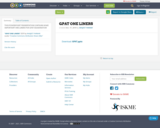
THIS POWERPOINT PRESENTATION CONTAINS SOME IMPORTANT ONE LINERS FOR GPAT EXAMINATION

This resource is a video abstract of a research paper created by Research Square on behalf of its authors. It provides a synopsis that's easy to understand, and can be used to introduce the topics it covers to students, researchers, and the general public. The video's transcript is also provided in full, with a portion provided below for preview:
"Research has identified remarkably effective treatments for breast cancer But translation of these results to all patients requires pharmacogenetic research using diverse patient populations Although tamoxifen has been used to reduce the risk of breast cancer recurrence for the past 40 years Little is known about how well the drug works in American Indian and Alaska Native (AIAN) people A recent study focused on genetic variants of the cytochrome P450 gene CYP2D6, which is critical for tamoxifen activation Looking at AIAN participants in Alaska and Montana they identified common CYP2D6 variants in these populations that may affect tamoxifen metabolism Patients with these variants may not respond well to tamoxifen treatment and may benefit from alternative therapies This study highlights the key role of CYP2D6-mediated metabolism in tamoxifen response and suggests that considering genetic variation in diverse populations can help to improve the efficacy of breast cancer treatment We thank women from the Confed.."
The rest of the transcript, along with a link to the research itself, is available on the resource itself.

This course reviews the key genomic technologies and computational approaches that are driving advances in prognostics, diagnostics, and treatment. Throughout the semester, emphasis will return to issues surrounding the context of genomics in medicine including: what does a physician need to know? what sorts of questions will s/he likely encounter from patients? how should s/he respond? Lecturers will guide the student through real world patient-doctor interactions. Outcome considerations and socioeconomic implications of personalized medicine are also discussed. The first part of the course introduces key basic concepts of molecular biology, computational biology, and genomics. Continuing in the informatics applications portion of the course, lecturers begin each lecture block with a scenario, in order to set the stage and engage the student by showing: why is this important to know? how will the information presented be brought to bear on medical practice? The final section presents the ethical, legal, and social issues surrounding genomic medicine. A vision of how genomic medicine relates to preventative care and public health is presented in a discussion forum with the students where the following questions are explored: what is your level of preparedness now? what challenges must be met by the healthcare industry to get to where it needs to be?
Lecturers
Dr. Atul J. Butte
Dr. Steven A. Greenberg
Dr. Alvin Thong-Juak Kho
Dr. Peter Park
Dr. Marco F. Ramoni
Dr. Alberto A. Riva
Dr. Zoltan Szallasi
Dr. Jeffrey Mark Drazen
Dr. Todd Golub
Dr. Joel Hirschhorn
Dr. Greg Tucker-Kellogg
Dr. Scott Weiss
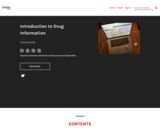
Word Count: 50749
(Note: This resource's metadata has been created automatically by reformatting and/or combining the information that the author initially provided as part of a bulk import process.)

This resource is a video abstract of a research paper created by Research Square on behalf of its authors. It provides a synopsis that's easy to understand, and can be used to introduce the topics it covers to students, researchers, and the general public. The video's transcript is also provided in full, with a portion provided below for preview:
"Scientists have recently developed a new system to screen cardiovascular medications for potential complications – using human heart cells. In the US the average time to develop and release a new drug to the public is 10-15 years. The average cost is nearly 5 billion dollars. A significant amount of this time and money is put into preclinical trials, in which animal models are used to test the safety of the drugs before human trials can begin. Due to biological differences, however, these models can’t fully capture the physiological properties of humans and, therefore, often fail to predict complications. In an attempt to remedy this, a team of researchers in the US set out to develop an alternative system to screen and predict potential safety concerns of drugs. To do this, the researchers used human induced pluripotent stem cells – cells derived from adults that have the ability to form many different types of tissues..."
The rest of the transcript, along with a link to the research itself, is available on the resource itself.

Let's Learn about Chirality is a video-based module that introduces the concept of chirality and stereoisomers to students. The module is an Open Educational Resources #OER containing short videos and fun quizzes* that you can take to test your understanding. In this module, you will learn to use different terms for stereoisomers and chiral molecules, recognize characteristics of stereoisomers, construct a model of 2-chlorobutane, identify the chiral carbons in chemical structures and assign absolute configurations to a molecule. The concluding video will briefly explain how chirality affects the chemistry of substances & pharmaceuticals. Click on View Resources and let's learn about Chirality.*For teachers, the Genial.ly quizzes are re-useable for your classes.*

This resource is a video abstract of a research paper created by Research Square on behalf of its authors. It provides a synopsis that's easy to understand, and can be used to introduce the topics it covers to students, researchers, and the general public. The video's transcript is also provided in full, with a portion provided below for preview:
"Mucoadhesion is a powerful mode of drug delivery. Prolonged exposure to mucosal tissue allows for drug release over an extended period of time, improving both compliance with drug treatment and convenience of use among patients. Unfortunately, there is no standard method for evaluating the performance of different mucoadesive drug formulations. Now, there’s MUCO-DIS, developed by University of Huddersfield. MUCO-DIS is an AFM- and microfluidics-based system that simultaneously measures four core functional properties of mucoadhesive formulations at the nanoscale: mucoadhesion force, 3D surface topography, polymer dissolution, and drug release characteristics. Researchers at University of Huddersfield used this newly developed MUCO-DIS to evaluate the performance of metformin mucoadhesive formulation..."
The rest of the transcript, along with a link to the research itself, is available on the resource itself.
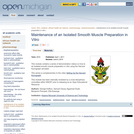
This module contains a series of demonstration videos on how to do isolated smooth muscle preparation in vitro using the Harvard Kymograph simulator. This series is complementary to the video Setting Up the Harvard Kymograph.This module has been internally reviewed by a cross-disciplinary committee within KNUST prior to releasing as an Open Educational Resource.

Word Count: 2804
(Note: This resource's metadata has been created automatically by reformatting and/or combining the information that the author initially provided as part of a bulk import process.)

This course addresses the scientific basis for the development of new drugs. The first half of the semester begins with an overview of the drug discovery process, followed by fundamental principles of pharmacokinetics, pharmacodynamics, metabolism, and the mechanisms by which drugs cause therapeutic and toxic responses. The second half of the semester applies those principles to case studies and literature discussions of current problems with specific drugs, drug classes, and therapeutic targets.
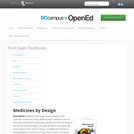
Medicines By Design aims to explain how scientists unravel the many different ways medicines work in the body and how this information guides the hunt for drugs of the future. Pharmacology is a broad discipline encompassing every aspect of the study of drugs, including their discovery and development and the testing of their action in the body. Much of the most promising pharmacological research going on at universities across the country is sponsored by the National Institute of General Medical Sciences (NIGMS), a component of the National Institutes of Health (NIH), U.S. Department of Health and Human Services. Working at the crossroads of chemistry, genetics, cell biology, physiology, and engineering, pharmacologists are fighting disease in the laboratory and at the bedside.

The neuropharmacology course will discuss the drug-induced changes in functioning of the nervous system. The specific focus of this course will be to provide a description of the cellular and molecular actions of drugs on synaptic transmission. This course will also refer to specific diseases of the nervous system and their treatment in addition to giving an overview of the techniques used for the study of neuropharmacology.
This course is offered during the Independent Activities Period (IAP), which is a special 4-week term at MIT that runs from the first week of January until the end of the month.
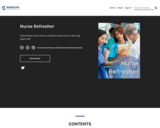
As the healthcare landscape evolves, so too does the need for nurses to stay current with advancements, best practices, and foundational concepts. Whether you’re re-entering the nursing field after a hiatus or seeking to enhance your existing skills, this book is designed to be your comprehensive guide to refreshing and expanding your nursing expertise.
In the fast-paced world of healthcare, it’s crucial to maintain and build upon your clinical competencies. This refresher text aims to bridge the gap between past experience and present-day practices, ensuring that you are well-prepared to deliver exceptional patient care. The content is carefully curated to address key areas of nursing practice, including updated clinical guidelines, emerging technologies, and evidence-based practices.
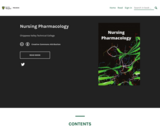
Word Count: 143265
(Note: This resource's metadata has been created automatically by reformatting and/or combining the information that the author initially provided as part of a bulk import process.)
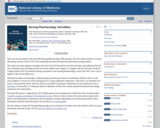
This is the second edition of the Open RN Nursing Pharmacology OER textbook. This free online textbook is an open educational resource with CC-BY 4.0 licensing that has been developed for prelicensure nursing students.
This edition has been updated according to the 2023 NCLEX-PN and NCLEX-RN Test Plans, and additional NCLEX Next Generation-style learning activities have been added to each chapter. It is aligned with the Wisconsin Technical College System (WTCS) statewide nursing curriculum for the Nursing Pharmacology course (543-103). View a list of updates in the second edition here.
This book introduces the principles of pharmacology and discusses classes of medications and their effects on the body. Emphasis is on the use of the nursing process to safely administer medications. This book is not intended to be used as a drug reference book. However, links are provided for prototype medications for each medication class to DailyMed, a trustworthy U.S. National Library of Medicine website, that contains detailed information about drugs marketed in the United States.
The Open RN project is supported by a $2.5 million grant from the Department of Education and is licensed under a Creative Commons Attribution 4.0 International License. However, these contents do not necessarily represent the policy of the Department of Education, and you should not assume endorsement by the federal government. More information about the Open RN project can be found at cvtc.edu/OpenRN.
The first edition of Open RN Nursing Pharmacology won an Award for Excellence from OE Global in 2020. For more information about the award, visit the 2020 OE Awards for Excellence site.
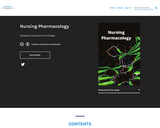
Word Count: 143694
ISBN: 9781734914108
(Note: This resource's metadata has been created automatically by reformatting and/or combining the information that the author initially provided as part of a bulk import process.)